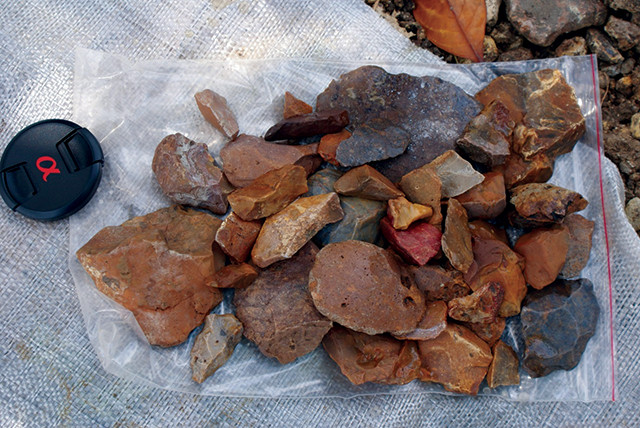
by Mary Caperton Morton Thursday, May 19, 2016

These stone artifacts were found scattered on the ground near Talepu Hill on the island of Sulawesi, and date to at least 118,000 years ago. Credit: Erick Setiabudi.
The island of Sulawesi is one link in a chain of islands between mainland Asia and Australia, and was likely an important stepping stone in human dispersal from Eurasia through Oceania to Australia. Previous research has placed modern humans on Sulawesi as early as 40,000 years ago, but scientists have now dated a set of stone tools to at least 118,000 years ago, suggesting humans occupied the island far earlier than thought.
Excavations conducted on Sulawesi between 2007 and 2012 uncovered four new early hominid sites and hundreds of lithic tools, including stone cores, choppers and flakes. Uranium dating of the soils containing the artifacts established an age range for the site between 194,000 and 118,000 years ago, which substantially predates indications from studies of limestone-encrusted rock art panels found on Sulawesi and attributed to modern humans.
Despite the rich stone tool record uncovered at Sulawesi, the team, led by Gerrit van den Bergh of the University of Wollongong in Australia, did not find any human remains, leaving the identity of the toolmakers a mystery. Reporting their findings in Nature, the team proposed three candidates for Sulawesi’s early occupation based on fossils found on other islands: Homo floresiensis, known to be on Flores roughly 190,000 years ago; Homo erectus, which appeared on Java 1.5 million years ago; or the enigmatic Denisovans, who could have reached Indonesia before modern humans.
Given the predominant flow of ocean currents through the island network of Indonesia, “we speculate that the most likely points of origin for the Sulawesi colonizers are Borneo to the west and the Philippines to the north, with the implication being that other islands in the region harbor undiscovered records of archaic hominins,” the team wrote.
© 2008-2021. All rights reserved. Any copying, redistribution or retransmission of any of the contents of this service without the expressed written permission of the American Geosciences Institute is expressly prohibited. Click here for all copyright requests.